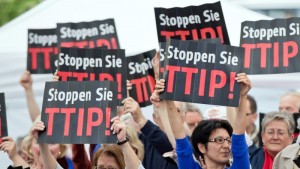 Last week, several demonstrations against the TTIP (Transatlantic Trade and Investment Partnership) were organized throughout Europe, in particular in Berlin and Brussels. This trade agreement between the U.S. and the EU is still under negotiation (the 11th round of negotiations is taking place in Miami on Oct. 19-23, 2015). The topics of contention are numerous.
Last week, several demonstrations against the TTIP (Transatlantic Trade and Investment Partnership) were organized throughout Europe, in particular in Berlin and Brussels. This trade agreement between the U.S. and the EU is still under negotiation (the 11th round of negotiations is taking place in Miami on Oct. 19-23, 2015). The topics of contention are numerous.
In addition to the tariffs cuts common to most international trade agreements, the TTIP aims to lower regulatory barriers. This is often perceived as an attack against the existing regulations. This perception not only exists in Europe, it is also shared in the U.S. but the topics of concern differ. The Americans for instance tend to favor their own financial regulations, while the European resistance is more focused on food, health or environmental regulation. The anti-TTIP feeling is clearly more spread within the population in Europe than in America.
Surprisingly for a country whose industry largely depends on exports, Germany has experienced a widespread opposition which focuses on the Investor-State Dispute Settlement (ISDS) mechanism, an arbitration system allowing private parties to take action against States’ measures which could jeopardize their investment (see the Deutsche Welle coverage here and the EurActiv.com page here). This system indeed gives the arbitrators the power to rule on policy measures that could affect private investments. Some fear it could deter governments to adopt stringent measures for instance to protect consumers or the environment. The lack of trust in the existing ISDS induced the Commission to come in September 2015 with “a new and transparent system for resolving disputes between investors and States” – the Investment Court System. According to the Commission (see here), “the proposal for the new court system includes major improvements such as:
- a public Investment Court System composed of a first instance Tribunal and an Appeal Tribunal would be set up;
- judgements would be made by publicly appointed judges with high qualifications, comparable to those required for the members of permanent international courts such as the International Court of Justice and the WTO Appellate Body;
- the new Appeal Tribunal would be operating on similar principles to the WTO Appellate Body;
- the ability of investors to take a case before the Tribunal would be precisely defined and limited to cases such as targeted discrimination on the base of gender, race or religion, or nationality, expropriation without compensation, or denial of justice;
- governments’ right to regulate would be enshrined and guaranteed in the provisions of the trade and investment agreement”.
It remains to be seen whether this new court system will respond to the concerns raised about the ISDS.
Regarding the content of TTIP, the Commission has prepared a short presentation in a 45 pages long document entitled Inside TTIP (see here). The document contains an overview of the various parts and chapters of TTIP (see p. 9), but does not otherwise go into details. Two pages of this document are devoted to IP issues (p. 45-46). In addition, part of the EU negotiating texts are released on another page of the DG Trade website. Only two meager proposals have been released so far (on IPR border measures and on Provisions in international agreements relating to IP) but an EU position paper is also available (the IPR EU position paper).
Here are the first two questions (on what the IP chapter of TTIP could include in the future):
- By reading those pages, could you identify the most important topic according to the Commission? Can you explain the issue?
- Does the Commission respond to the fears expressed in the press on the IP chapter of TTIP? To prepare your response, you should compare the view expressed by the Commission with what appears in the online press and on the webpages of the TTIP opponents.
In parallel the US is negotiating the TPP (Trans-Pacific Partnership) with 11 countries around the Pacific ocean. On October 5, 2015, the U.S. and the other negotiating countries announced that a deal on the TPP had been reached. The IP chapter of the TPP seems more developed and more contentious than what could/will be included in the IP chapter of TTIP. WikiLeaks released the controversial IP chapter of TPP on Oct. 9, 2015 (see the open media.ca page with the link to WikiLeaks).
Here are the questions concerning the TPP text recently released:
- Does the rule on exhaustion of IP deviate from the existing rule in international trade law (TRIPs)?
- What is the dispute settlement procedure imposed for domain name cybersquatting? Can you very briefly explain this ADR system?
- What were the most controversial issues during the negotiation of the IP chapter? You should consult the online coverage by the press and dedicated websites to respond to this question. The openmedia.ca page is only one reference among others to rely on. What do you find in the TPP text on those issues?
- Is there an extension of copyright protection which will result in global regulatory convergence?
- Are the rights belonging to copyright defined in the same way as in Europe (compare with the 2001/29 InfoSoc Directive)?
This exercise should help you to bridge the gap between the debates in the press on those international trade agreements and the detailed legal provisions adopted at the end of the process.
Good work!

